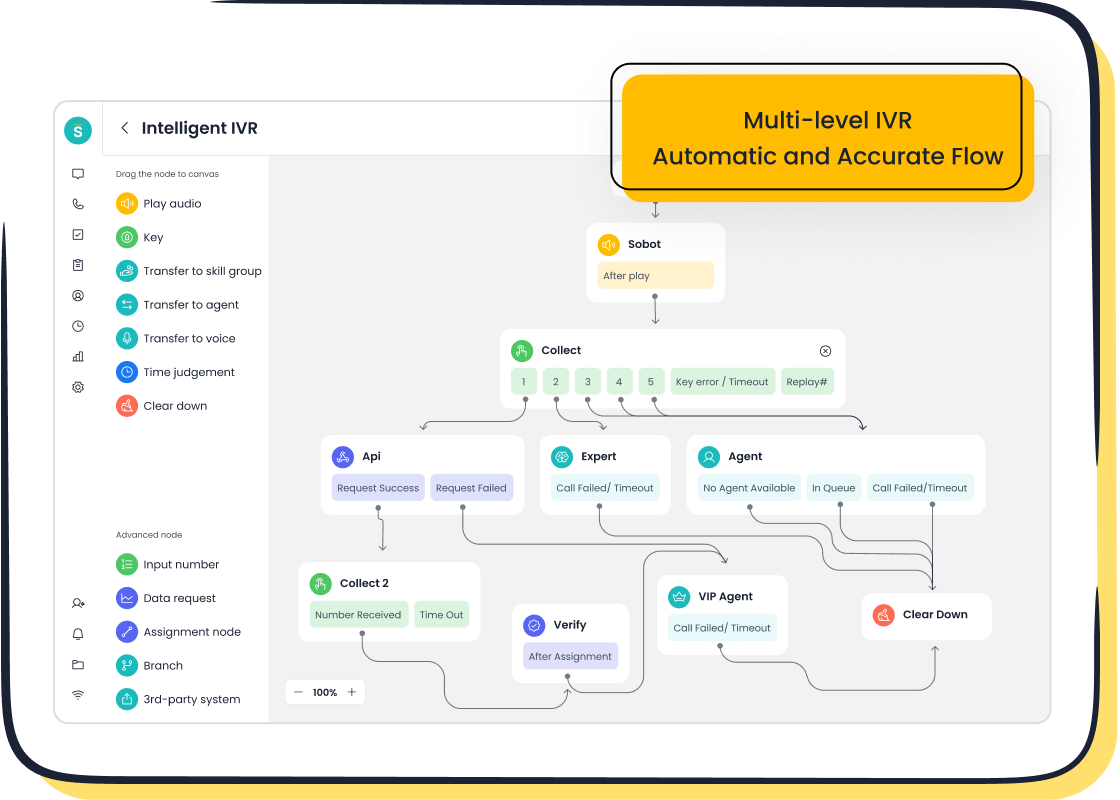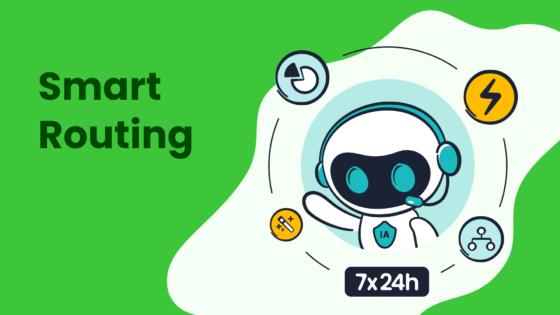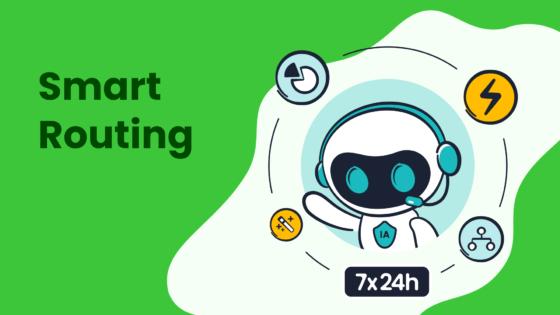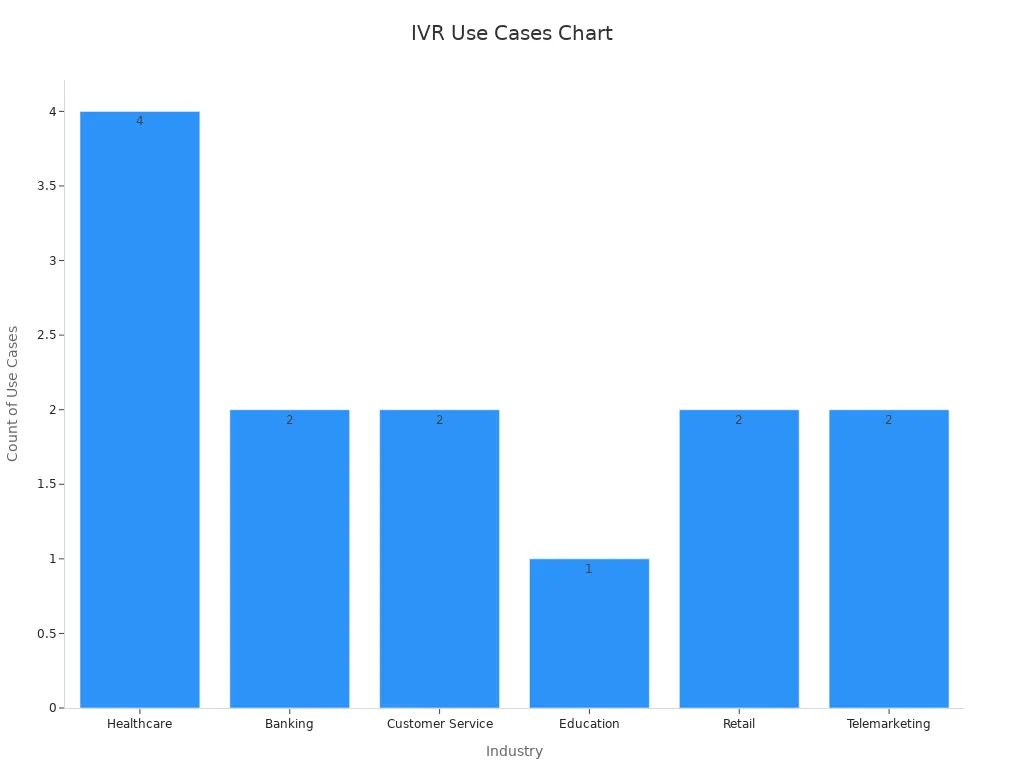How an IVR System Works and Enhances Communication

An IVR system, or interactive voice response, is a technology that enables interaction with a company's phone system using voice commands or keypad inputs. For those wondering, "what is an IVR system?"—it acts as a virtual assistant, efficiently directing callers to the appropriate information or department without requiring human intervention. By automating tasks like call routing and information retrieval, IVR systems save valuable time for both customers and businesses.
These systems play a crucial role in enhancing communication efficiency. In one study, 86 participants expressed high satisfaction with the system, and 66% stated they would recommend it to others. With Sobot's cutting-edge IVR technology, businesses can deliver seamless, intelligent interactions that elevate service quality and boost customer satisfaction.
What Is an IVR System and Its Purpose?
Definition of Interactive Voice Response (IVR)
Interactive voice response, or IVR, is an automated telecommunication technology that interacts with callers using voice commands or keypad inputs. It allows businesses to handle routine tasks like answering common questions or directing calls to the right department. By automating these processes, IVR systems improve efficiency and reduce the need for human intervention. For example, when you call a customer service line and hear a menu of options, that’s an IVR system at work. These systems are built on technologies like VoiceXML and integrate with telephone networks and databases to provide real-time responses.
Key Features of IVR Systems
IVR systems come with a variety of features that enhance their functionality and usability. Some of the most notable include:
- Smart Call Routing: Automatically directs calls to the appropriate department or agent.
- Self-Service Options: Allows customers to resolve issues independently, such as checking account balances or tracking orders.
- 24/7 Availability: Ensures constant access to support, even outside business hours.
- Speech Recognition: Enables natural interactions by understanding voice commands.
- Data Collection: Gathers caller information to personalize responses and improve services.
These features make IVR systems a valuable tool for businesses of all sizes. Approximately 70% of medium to large enterprises use IVR systems, and adoption among small businesses is growing due to cloud-based solutions.
The Role of IVR in Modern Communication
IVR systems play a crucial role in today’s fast-paced world. They help businesses manage high volumes of customer interactions while maintaining consistency and quality. For instance, IVR systems can handle up to 80% of routine inquiries without human assistance, reducing wait times and improving customer satisfaction. They also enhance first-call resolution rates by 10-15%, ensuring that customers get the help they need quickly.
The demand for interactive voice response systems continues to grow across industries like retail, healthcare, and finance. By integrating with backend systems, IVR solutions provide personalized experiences, making them indispensable in modern communication strategies. The global IVR software market is projected to reach $6.1 billion by 2030, highlighting their importance in the future of customer service.
How IVR Systems Work: A Technical Overview

Call Reception and Initial Interaction
When you call a business using an IVR system, the process begins with a seamless reception. The system immediately connects you to an automated telephony system, which greets you with a pre-recorded or dynamically generated message. This introductory message often outlines the menu options available, helping you navigate the system efficiently.
Here’s how the process unfolds:
- Call Initiation: You dial the number linked to the IVR system. The system instantly recognizes your call and activates its interface.
- Greeting and Menu Presentation: The system plays a welcome message, followed by a list of menu options tailored to your needs. For example, you might hear, “Press 1 for billing inquiries or 2 for technical support.”
- User Input Handling: As you make a selection, the system captures your input, whether it’s a keypad entry or a spoken command.
This initial interaction sets the tone for the rest of your experience. Modern IVR technology ensures that these steps are quick and intuitive, minimizing frustration and saving time. Businesses like Weee! have leveraged Sobot’s IVR systems to enhance this phase, offering multilingual greetings and flexible menu options to cater to diverse customer bases.
User Input Processing: DTMF and Speech Recognition
Once you’ve selected an option, the IVR system processes your input using advanced technologies like DTMF (Dual-Tone Multi-Frequency) and speech recognition. These technologies allow the system to interpret your commands accurately, ensuring a smooth interaction.
- DTMF Input: When you press a number on your phone’s keypad, it generates a unique tone. The IVR software decodes this tone to identify your selection. For instance, pressing “1” might direct you to account services.
- Speech Recognition: If the system supports voice commands, it uses speech recognition to understand your spoken words. This feature is especially useful in self-service IVR systems, where natural language processing enables more conversational interactions.
These input methods work together to make IVR systems versatile and user-friendly. For example, Sobot’s intelligent IVR technology combines DTMF and speech recognition to offer a hybrid approach, accommodating both traditional and tech-savvy users. This adaptability ensures that everyone can navigate the system with ease.
Call Routing and Information Retrieval
After processing your input, the IVR system routes your call or retrieves the information you need. This step is where the system’s intelligence truly shines. It uses predefined rules and real-time data to ensure you’re connected to the right resource.
- Call Routing: The system directs your call based on criteria like your input, account details, or even the time of day. For example, if you select “technical support,” the system might route you to an agent specializing in troubleshooting.
- Information Retrieval: If your request involves specific data, such as your account balance or order status, the system accesses its database to fetch the relevant details. This information is then delivered to you via an audio response.
Advanced IVR systems, like those offered by Sobot, integrate with backend systems to enhance these processes. Features like Automatic Call Distribution (ACD) ensure that calls are routed efficiently, reducing wait times and improving call handling metrics. Additionally, time-based routing optimizes agent availability during peak hours, ensuring a seamless experience for you.
By automating these tasks, IVR systems not only improve efficiency but also free up human agents to focus on complex queries. This balance between automation and human intervention makes IVR technology an indispensable tool for modern businesses.
Integration with Backend Systems and Sobot's Voice/Call Center
IVR systems rely on backend integration to deliver seamless and efficient communication experiences. When you interact with an IVR, the system connects to databases, CRM platforms, and other backend tools to retrieve or process information. This integration ensures that your requests are handled accurately and quickly. For example, if you ask for your account balance, the IVR system accesses the database in real time to provide the correct details.
Backend integration also enables advanced features like personalized responses. By linking the IVR to customer profiles stored in a CRM, businesses can tailor interactions based on your preferences or history. This level of customization improves customer satisfaction and builds trust.

Sobot’s Voice/Call Center takes backend integration to the next level. Its intelligent IVR technology connects effortlessly with existing systems, including CRMs like Salesforce and Shopify. This integration allows businesses to unify customer data and streamline operations. For instance, when you call a company using Sobot’s IVR, the system can instantly pull up your order history or support tickets, ensuring faster resolutions.
The platform also supports encrypted data transfer, guaranteeing the security of sensitive information during interactions. With a 99.99% uptime, Sobot’s Voice/Call Center ensures reliable performance even during peak hours. Its AI-powered Voicebot enhances backend integration by recognizing customer intent and automating routine tasks. This reduces the workload on agents and allows them to focus on complex issues.
Imagine a retail business using Sobot’s IVR systems. When you call to check the status of your delivery, the system retrieves the tracking details from the backend and provides them instantly. If you need further assistance, the IVR routes your call to the right agent based on your query type. This seamless integration saves time and improves your overall experience.
Sobot’s Voice/Call Center also offers global number availability, making it ideal for businesses with international customers. Its time zone support ensures that you receive timely assistance, no matter where you are. These features demonstrate how backend integration enhances the functionality of IVR systems, making them indispensable for modern businesses.
Tip: Backend integration is the backbone of IVR systems. It ensures that every interaction is accurate, secure, and efficient.
Types of IVR Systems and Their Use Cases
Single-Level vs. Multi-Level IVR Systems
IVR systems can be categorized into single-level and multi-level types based on their menu structure. A single-level IVR offers a straightforward menu with limited options. For example, when you call a retail store, you might hear, “Press 1 for store hours or 2 for customer service.” This type works well for businesses with simple needs and fewer departments.
On the other hand, multi-level IVR systems provide a more detailed menu structure. These systems guide you through multiple layers of options to address complex inquiries. For instance, a healthcare provider might use a multi-level IVR to direct you to appointment scheduling, prescription refills, or billing support. Multi-level IVR systems are ideal for industries like healthcare, banking, and customer service, where diverse services require precise call routing.
Hosted vs. On-Premise IVR Systems
Hosted IVR systems operate on cloud-based platforms, offering flexibility and scalability. These systems allow you to manage calls without investing in expensive hardware. Businesses often choose hosted IVR systems for their cost-effectiveness and ease of deployment. For example, a telemarketing company can use a hosted IVR to handle high call volumes during campaigns.
In contrast, on-premise IVR systems require physical infrastructure and are managed internally. These systems provide greater control and customization but involve higher upfront costs. Industries like banking and government services often prefer on-premise IVR systems for enhanced security and data privacy.
Advanced IVR Types: Speech-Enabled and Conversational IVR
Advanced IVR systems leverage technologies like AI and natural language processing (NLP) to enhance user interactions. Speech-enabled IVR allows you to navigate menus using voice commands. For example, in healthcare, you can say, “Schedule an appointment” to connect with the right department. This feature improves accessibility for users who may find keypad navigation challenging.
Conversational IVR takes it a step further by enabling natural, human-like interactions. These systems understand context and intent, making your experience more intuitive. For instance, when booking a flight, a conversational IVR can handle requests like, “I need a ticket to New York next Friday.” Businesses in travel, retail, and customer service increasingly adopt these systems to meet rising customer expectations.
The growing adoption of advanced IVR systems reflects their ability to deliver personalized and efficient service. According to market research, the IVR market is projected to grow from $5.56 billion in 2024 to $9.26 billion by 2031, driven by the demand for intelligent interactions and cost savings.

Tip: Choose the right type of IVR system based on your business needs. Hosted systems suit growing businesses, while on-premise systems offer robust security for sensitive data.
Use Cases Across Industries with Sobot's Solutions
Sobot’s IVR systems have transformed communication across industries by offering tailored solutions that meet specific needs. Whether you work in retail, healthcare, or finance, these systems streamline customer interactions and improve service quality.
Retail and E-Commerce
In retail, IVR systems simplify order tracking and customer inquiries. Imagine calling a store to check your delivery status. Sobot’s IVR retrieves the information instantly, saving you time. Businesses like Weee! have seen remarkable results. By using Sobot’s flexible IVR, Weee! reduced resolution times by 50% and achieved a 96% customer satisfaction score. Multilingual support ensures customers from diverse backgrounds feel valued.
Healthcare
Healthcare providers use IVR systems to manage appointment scheduling and prescription refills. Sobot’s IVR integrates with backend systems to access patient records securely. When you call to book an appointment, the system identifies your profile and offers available slots. This automation reduces administrative workload and ensures faster service.
Banking and Financial Services
Banks rely on IVR systems for secure account management. Sobot’s IVR allows you to check balances, transfer funds, or report lost cards without waiting for an agent. Its AI-powered Voicebot enhances security by verifying your identity through voice recognition. This feature builds trust and ensures sensitive data remains protected.
Gaming and Entertainment
In gaming, IVR systems handle player support efficiently. Sobot’s conversational IVR understands complex queries, such as “Why can’t I access my account?” It routes calls to the right team or provides instant solutions. This reduces downtime and keeps players engaged.
Education
Educational institutions use IVR systems to manage admissions and student inquiries. Sobot’s IVR offers 24/7 availability, ensuring students can access information anytime. For example, when you call to check application status, the system retrieves details from the database and provides updates immediately.
Sobot’s IVR solutions adapt to the unique challenges of each industry. With features like smart call routing, multilingual support, and backend integration, these systems enhance communication and operational efficiency.
Note: Sobot’s IVR systems are trusted by global brands like Samsung and Philips. Learn more about their solutions here.
Benefits of IVR Systems in Enhancing Communication
Smart Call Routing and Reduced Wait Times
IVR systems excel at directing calls to the right destination quickly. When you interact with an IVR, it analyzes your input and routes your call based on predefined rules or customer intent. This intelligent call routing reduces wait times and ensures you connect with the right agent or department immediately. For example, if you select "technical support," the system identifies the best agent available and transfers your call without unnecessary delays.
Businesses using smart IVR technologies report significant improvements in operational efficiency. Companies have seen up to a 25% increase in first-call resolution rates, as calls are routed to agents with the right expertise. Additionally, average handling times drop because calls reach their correct destination faster. These benefits enhance customer experience by minimizing frustration and saving time.
| Feature | Benefit |
|---|---|
| Intelligent Call Routing | Shorter wait times and improved customer satisfaction. |
| Improved First Call Resolution | Up to 25% increase due to skill-based routing. |
| Reduced Average Handling Time | Faster call handling and fewer transfers. |
Sobot’s IVR systems take smart routing a step further by integrating with backend systems. This ensures that calls are routed based on real-time data, such as customer history or preferences. For instance, when you call a retail business using Sobot’s IVR, the system can prioritize your query based on your purchase history, ensuring a personalized experience.
Tip: Intelligent call routing not only saves time but also boosts customer satisfaction by connecting you to the right resource immediately.
24/7 Availability and Scalability
IVR systems operate round the clock, providing uninterrupted service to customers. Whether you need assistance during business hours or late at night, the system is always available to handle your inquiries. This 24/7 availability ensures you can access information or resolve issues without waiting for live agents. For example, you can check your account balance or track an order at any time, even on weekends or holidays.
Scalability is another key advantage of IVR systems. As call volumes grow, businesses can expand their IVR capabilities without hiring additional staff. This makes IVR systems ideal for companies experiencing seasonal spikes in customer interactions, such as during holiday sales or product launches.
| Benefit Description | Source Link |
|---|---|
| Round-the-clock service ensures constant access to information. | IVR Lab |
| Reduces operational costs by eliminating the need for live agents outside business hours. | Technology Advice |
| Handles growing call volumes without requiring additional staff. | Hello Duty |
Sobot’s IVR systems offer global number availability and time zone support, making them perfect for businesses with international customers. Imagine calling a company from a different time zone and receiving immediate assistance. With Sobot’s IVR, businesses can provide seamless service to customers worldwide, enhancing communication and accessibility.
Note: 24/7 availability ensures you never have to wait for assistance, while scalability allows businesses to grow without proportional increases in costs.
Cost Efficiency and Resource Optimization
IVR systems automate routine tasks, reducing the need for live agents and lowering labor costs. When you use an IVR to check your account balance or schedule an appointment, the system handles your request without human intervention. This automation improves operational efficiency and allows businesses to allocate their workforce to more complex tasks.
In healthcare, IVR systems have demonstrated their ability to optimize resources. A study involving 902 heart failure patients showed that IVR implementation increased medication adherence and reduced hospital readmission rates. These outcomes highlight how IVR systems save costs while improving service quality.
Unnecessary errors also decrease with IVR automation. By minimizing human involvement in routine processes, businesses avoid error-related costs and improve accuracy. Additionally, IVR systems handle high call volumes without requiring additional infrastructure, making them a cost-effective solution for growing businesses.
- IVR systems lower labor costs by automating routine tasks.
- Operational efficiency improves as fewer calls require human intervention.
- Error-related costs decrease due to automation, reducing the need for corrections.
- High call volumes are managed without additional physical infrastructure.
- Scalability allows businesses to upgrade without proportional cost increases.
Sobot’s IVR systems enhance cost efficiency through features like AI-powered Voicebot and encrypted data transfer. These technologies ensure secure and accurate interactions, reducing operational risks. For example, when you call a financial institution using Sobot’s IVR, the system verifies your identity and processes your request securely, saving time and resources.
Callout: IVR systems optimize resources and reduce costs, making them indispensable for businesses aiming to improve efficiency and customer experience.
Enhanced Customer Experience with Sobot's Intelligent IVR
Sobot's intelligent IVR transforms how businesses interact with their customers. It creates a seamless, personalized, and efficient communication experience. By leveraging advanced technologies like AI and natural language processing, Sobot ensures that every interaction feels intuitive and human-like.
Personalized Interactions for Every Caller
Sobot's IVR adapts to individual customer needs. When you call a business using this system, it identifies your profile and tailors the interaction based on your history. For example, if you frequently inquire about order tracking, the system prioritizes that option in the menu. This personalization saves time and makes you feel valued as a customer.
Multilingual Support for Global Reach
Language barriers often hinder effective communication. Sobot's IVR eliminates this challenge by offering multilingual support. Whether you speak English, Spanish, or Mandarin, the system ensures you receive assistance in your preferred language. This feature is especially beneficial for global businesses like Weee!, which cater to diverse customer bases. By implementing Sobot's IVR, Weee! achieved a 96% customer satisfaction score, demonstrating the system's effectiveness.
Faster Resolutions with Smart Call Routing

Long wait times frustrate customers. Sobot's IVR addresses this issue with smart call routing. The system analyzes your input and connects you to the right agent or department instantly. For instance, if you select "technical support," the IVR ensures you reach an expert who can resolve your issue quickly. Businesses using Sobot's IVR report up to a 25% increase in first-call resolution rates, highlighting its impact on efficiency.
24/7 Availability for Uninterrupted Support
Sobot's IVR operates round the clock, ensuring you can access support anytime. Whether you need help during business hours or late at night, the system is always ready to assist. This 24/7 availability enhances customer satisfaction by providing uninterrupted service. For example, you can check your account balance or schedule an appointment even on weekends or holidays.
Secure and Reliable Interactions
Security is a top priority for Sobot's IVR. The system uses encrypted data transfer to protect sensitive information during interactions. With a 99.99% uptime, it guarantees reliable performance, even during peak hours. This stability builds trust and ensures a smooth experience for every caller.
Sobot's intelligent IVR redefines customer experience by combining personalization, efficiency, and security. It empowers businesses to deliver exceptional service while optimizing their operations. Whether you're a customer seeking quick resolutions or a business aiming to enhance communication, Sobot's IVR is the ideal solution.
Tip: Businesses can explore Sobot's Voice/Call Center to experience the full potential of intelligent IVR. Learn more here.
Real-World Applications of IVR Systems

Call Centers and Customer Service Centers
IVR systems have revolutionized call centers and customer service environments. When you call a business, the system handles your inquiry efficiently, reducing wait times and improving your experience. Companies use IVR to automate routine tasks, such as answering frequently asked questions or directing calls to the right department. This automation allows agents to focus on complex issues, enhancing overall productivity.
Many businesses have seen remarkable results with IVR systems. Telefónica manages over 1 million calls monthly, achieving a 6% increase in first-call resolution and a 68% call handling rate. Swisscom handles 9 million calls annually, with 80% of inquiries resolved through self-service. HelloFresh automated over 30% of customer interactions, streamlining routine inquiries and improving customer satisfaction.
| Company | Key Outcomes |
|---|---|
| Telefónica | - Managed 1 million calls/month - 6% increase in first call resolution - 68% call handling rate |
| Swisscom | - 25% increase in correct transfers - 9 million calls annually - 80% self-service rate |
| HelloFresh | - Automated over 30% of customer interactions - Streamlined routine inquiries - Improved customer experience |
IVR systems also reduce agent workloads. ING Bank Turkey integrated a conversational IVR system, cutting agent workloads by half and increasing customer payment promises by nearly 60%. These examples show how IVR systems improve efficiency and enhance customer service.
Healthcare and Appointment Scheduling
In healthcare, IVR systems simplify appointment scheduling and prescription refills. When you call a clinic, the system identifies your profile and offers available slots for appointments. This automation reduces administrative tasks and ensures faster service.
IVR systems also provide reminders for upcoming appointments or medication schedules. These features improve patient adherence to treatments and reduce missed appointments. For example, a hospital can use IVR to send automated reminders, ensuring patients stay informed about their healthcare needs.
By integrating with backend systems, IVR technology retrieves patient records securely. This ensures accurate information during interactions. Healthcare providers benefit from reduced workloads, while you enjoy quicker and more reliable service.
Banking and Financial Services
Banks rely on IVR systems to handle secure account management. When you call your bank, the system allows you to check balances, transfer funds, or report lost cards without waiting for an agent. This automation saves time and ensures your sensitive information remains protected.
IVR systems also enhance security through voice recognition. When you verify your identity using your voice, the system ensures only authorized users access your account. This builds trust and improves your experience.
Financial institutions use IVR to manage high call volumes efficiently. For example, during tax season, banks can handle inquiries about account statements or payment schedules without overwhelming their staff. This scalability makes IVR systems indispensable for the financial sector.
Retail and E-Commerce with Sobot's Voice/Call Center
Retail and e-commerce businesses face unique challenges in managing customer interactions. High call volumes, order tracking inquiries, and multilingual customer bases require efficient solutions. Sobot's voice/call center, powered by advanced ivr technology, addresses these needs effectively.
When you call a retail business, an ivr system greets you with a menu of options. It allows you to check order statuses, track deliveries, or connect with the right department. This automation reduces wait times and ensures you get the information you need quickly. For example, Weee!, a leading online Asian supermarket, implemented Sobot's ivr system to handle its growing customer base. The result? A 50% reduction in resolution time and a 96% customer satisfaction score.
Sobot's ivr also supports multilingual interactions. If you speak Spanish or Mandarin, the system provides assistance in your preferred language. This feature is crucial for global e-commerce businesses that serve diverse audiences. Additionally, the system integrates seamlessly with backend tools like CRMs. This integration ensures that when you call, the ivr retrieves your order history or account details instantly, offering a personalized experience.

Scalability is another advantage. During peak shopping seasons, such as Black Friday, Sobot's ivr handles increased call volumes without compromising performance. Its 99.99% uptime guarantees reliable service, even during high-demand periods. With features like smart call routing and AI-powered voicebots, Sobot's ivr enhances both customer satisfaction and operational efficiency.
By adopting Sobot's voice/call center, retail and e-commerce businesses can streamline their communication processes. This not only improves customer experiences but also optimizes resources, making it a valuable investment for any growing business.
Tip: Learn more about how Sobot's ivr solutions can transform your retail operations here.
IVR systems revolutionize communication by automating tasks like call routing and data retrieval. They enhance customer experiences through personalization, 24/7 availability, and efficient call handling. AI-powered IVR systems understand diverse voice commands, enabling faster and more accurate interactions. Businesses benefit from reduced costs, improved service quality, and seamless integration with backend systems.
Sobot's Voice/Call Center offers cutting-edge IVR technology with smart routing, multilingual support, and global scalability. These features ensure reliable, secure, and efficient communication. By adopting Sobot's solutions, you can transform customer service and optimize operations for long-term success.
Tip: Explore Sobot's Voice/Call Center to elevate your communication strategy.
FAQ
What is the difference between IVR and a live agent?
IVR automates routine tasks like call routing and information retrieval. It works without human intervention. A live agent handles complex queries that require empathy or problem-solving. Combining both ensures efficiency and personalized service.
Tip: Use IVR for quick tasks and live agents for detailed assistance.
Can small businesses benefit from IVR systems?
Yes, small businesses can use IVR to handle calls efficiently. It reduces costs by automating tasks like answering FAQs or routing calls. Cloud-based IVR systems are affordable and scalable, making them ideal for growing businesses.
How does Sobot’s IVR ensure data security?
Sobot’s IVR uses encrypted data transfer to protect sensitive information. It complies with global security standards, ensuring your data remains safe during interactions. With a 99.99% uptime, it guarantees reliable and secure communication.
Is it easy to integrate Sobot’s IVR with existing systems?
Yes, Sobot’s IVR integrates seamlessly with CRMs like Salesforce and Shopify. This integration unifies customer data, enabling personalized interactions. You can deploy it quickly without disrupting your current operations.
What industries benefit the most from IVR systems?
Industries like retail, healthcare, banking, and customer service gain the most. IVR systems streamline tasks like order tracking, appointment scheduling, and account management. They improve efficiency and enhance customer satisfaction across these sectors.
Emoji Insight: 🏥 Healthcare, 🛒 Retail, and 💳 Banking thrive with IVR solutions.
See Also
Understanding The Functionality Of IVR Voice Recognition Software
Key Features Of Interactive Voice Response System Software
Step-By-Step Guide For Setting Up IVR Software
Best 10 IVR Interactive Voice Response Software For 2024
Comparative Analysis Of Leading Interactive Voice Response Software
